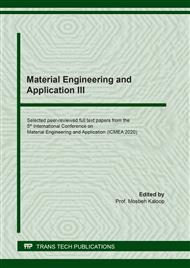[1]
Ming Zhang L, Chang Yu K, Jin Bo Y. Research situation of concrete accelerator using aluminium sulfate[J]. concrete, 2012, 20(9): 39-42.
Google Scholar
[2]
Zhong Cheng M, Lan W, Jing Yu M. Development of shotcrete technologies and accelerators[J]. Concrete, 2011, 28(12): 126-128.
Google Scholar
[3]
Zheng An Z, Xiang Qun D, Yang P, et al. Performance and action mechanism of alkali-free liquid accelerating agent[J]. Concrete, (2011).
Google Scholar
[4]
R. Salvador, P. Cavalaro, S. Henrique, et al. Effect of cement composition on the reactivity of alkali-free accelerating admixtures for shotcrete[C]. International Symposium on Sprayed Concrete. (2014).
Google Scholar
[5]
Qiu Y, Ding B, Gan J, et al. Mechanism and preparation of liquid alkali-free liquid setting accelerator for shotcrete, IOP Conf. Ser.: Mater. Sci. Eng. 182 (2017) 012034.
DOI: 10.1088/1757-899x/182/1/012034
Google Scholar
[6]
Ji Liang W, Jing Liang S, Kang L, et al. Study on the Alkali-Free Liquid Accelerator[J]. Applied Mechanics & Materials, 2014, 584-586: 1264-1270.
DOI: 10.4028/www.scientific.net/amm.584-586.1264
Google Scholar
[7]
Yan Ping S, Bin X, Hai Bin L, et al. Preparation and Performance of a New-Type Alkali-Free Liquid Accelerator for Shotcrete[J]. Advances in Materials Science & Engineering, 2017, 2017: 1-9.
Google Scholar
[8]
Zhong Cheng M, Lan W, Jing Yu M. Study on the preparation and performance of a new alkali-free and chloride-free liquid accelerator[C]. Mater. Sci. Forum (2012).
Google Scholar
[9]
Yan Dong S, Yan Pei G, Wen Quan Z, et al. Influence of New Compound Admixture on Shotcrete Performance[J]. Journal of Wuhan University of Technology(Materials ence Edition), 2017, 032(006): 1392-1396.
Google Scholar
[10]
Jing Yu M, Zhong Cheng M, Wang L, et al. Performance and Mechanism of a New Alkali-free and Chloride-free Liquid Accelerator[J]. Journal of Wuhan University of Technology, (2012).
Google Scholar
[11]
Liu G, Cheng W, Chen L. Investigating and optimizing the mix proportion of pumping wet-mix shotcrete with polypropylene fiber[J]. Construction and Building Materials. 2017, 150: 14-23.
DOI: 10.1016/j.conbuildmat.2017.05.169
Google Scholar
[12]
Yu W, Bengxiu L, Juan C, et al. Research on Preparation and Characterization of a Low-alkali Liquid Flash Accelerator Admixture[J]. Shandong Chemical Industry, (2018).
Google Scholar
[13]
Yaphary Y L, Yu Z C, Raymond H W L, et al. Effect of triethanolamine on cement hydration toward initial setting time[J]. Construction and Building Materials, 2017, 141: 94-103.
DOI: 10.1016/j.conbuildmat.2017.02.072
Google Scholar
[14]
Xiong Fei H, Xun Z. Study on Acceleration Mechanism of Liquid Alkali-free Accelerating Component[J]. Tunnel Construction, 2014, 34(12): 1131-1136.
Google Scholar
[15]
Moraruds. Method for the protection of concrete in seawater[M]: US, 4258090A. 1981-3-24.
Google Scholar


